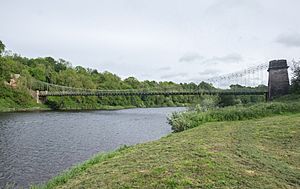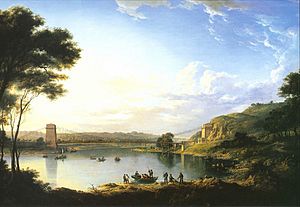Union Bridge, Tweed facts for kids
Quick facts for kids Union Bridge |
|
|---|---|

The bridge from the north on the Scottish bank
|
|
| Coordinates | 55°45′09″N 2°06′25″W / 55.7525°N 2.107°W |
| Crosses | River Tweed |
| Characteristics | |
| Number of spans | 1 |
| History | |
| Designer | Captain Samuel Brown |
| Construction begin | 1819 |
| Opened | 26 July 1820 |
| Lua error in Module:Location_map at line 420: attempt to index field 'wikibase' (a nil value). | |
The Union Bridge, also called the Union Suspension Bridge or Union Chain Bridge, is a special bridge that crosses the River Tweed. This river forms part of the border between England and Scotland. The bridge connects Horncliffe in Northumberland, England, with Fishwick in Berwickshire, Scotland.
When it first opened in 1820, the Union Bridge was the longest suspension bridge in the world made of wrought iron. It stretched 449 feet (137 meters) across the river. It was also the first bridge of its kind in the United Kingdom that vehicles could use. Even though another famous bridge, the Menai Suspension Bridge, started being built earlier, the Union Bridge was finished first. Today, it is the oldest suspension bridge in the world that still carries road traffic. It is considered a very important historic building in both Scotland and England.
Contents
Bridge History: A Look Back


Before the Union Bridge was built, crossing the River Tweed in this area was quite hard. People had to travel a long way around. They could go 11 miles (18 km) downstream to Berwick-upon-Tweed or 20 miles (32 km) upstream to Coldstream. Sometimes, people would cross the river by walking or riding through the shallow parts. But this was impossible when the water was high. To make things easier, a group called the Berwick and North Durham Turnpike Trust decided a new bridge was needed.
Building the Bridge: How It Was Made
The Union Bridge was designed by a clever English naval officer named Captain Samuel Brown. He joined the Navy in 1795. He noticed that the ropes used on ships, made of hemp, often broke. This caused ships to be lost. Captain Brown thought that strong iron chains would be much better.
He hired skilled blacksmiths to create experimental chains made of wrought iron. In 1806, one of his ships, HMS Penelope, was fitted with these new iron ropes. It worked very well during a test trip. Because of this success, in 1808, Captain Brown and his cousin Samuel Lenox started a company. This company later became known as Brown Lenox & Co.
Captain Brown left the Navy in 1812. In 1813, he built a small test suspension bridge. It was 105 feet (32 meters) long and used 296 stone (1,880 kg) of iron. This test bridge was strong enough to hold a carriage. Famous engineers like John Rennie and Thomas Telford were impressed by it.
Captain Brown received a patent in 1816 for how to make these special chains. Then, in July 1817, he got another patent for how to build a bridge using these parts. He even suggested building a much bigger bridge, 1,000 feet (300 meters) long, over the River Mersey. However, that bridge was never built. It's not fully known why Captain Brown got involved with the Union Bridge project, but he agreed to design it in September 1818.
Captain Brown was an expert in ironwork, but he didn't know much about building with stone. So, John Rennie helped with the stone parts of the bridge. The plan for the bridge was approved in July 1819. Construction began very quickly, on August 2, 1819.
The bridge was officially opened on July 26, 1820. Many people attended the opening ceremony, including the well-known Scottish engineer Robert Stevenson. Captain Brown himself tested the bridge first. He drove a special carriage pulling twelve carts across it. About 700 people watched this exciting event. For many years, people had to pay a small fee, called a toll, to cross the bridge. The small house where tolls were collected was at the English end. It was taken down in 1955.
Bridge Changes Over Time
In 1883, the system of paying tolls was stopped. The responsibility for looking after the bridge then went to the Tweed Bridges Trust. Later, the bridge became the responsibility of Scottish Borders Council and Northumberland County Council. Northumberland County Council now maintains it.
The bridge has been strengthened and repaired many times over the years. In 1902, extra cables were added to make it stronger. The main part of the bridge where cars drive was largely rebuilt in 1871 and again in 1974. The chains that hold the bridge up have also been reinforced many times.
In 2007, the bridge was closed to cars for several months. This happened because one of the hangers, which help support the bridge, broke. A temporary part was put in place so the bridge could reopen. In December 2008, the bridge had to close again because of a landslide. In 2013, there was talk of closing the bridge permanently because there wasn't enough money to fix it.
However, in October 2014, local people and groups started a campaign. They wanted the bridge to be fully repaired in time for its 200th birthday in 2020. In 2013, the bridge was added to Historic England's "Heritage at Risk" list, meaning it needed urgent care.
Restoration Project: Saving the Bridge
In March 2017, the councils responsible for the bridge, Scottish Borders Council and Northumberland County Council, agreed to each contribute £550,000 towards a big restoration project. At that time, the total cost was expected to be around £5 million. By August 2020, more money had been promised by both councils, the National Lottery Heritage Fund, and Historic England.
The work was then expected to cost £10.5 million. It began in October 2020 and was planned to take about 18 months. The old chains were carefully cut in March 2021. The restored bridge was expected to reopen in early 2022, ready for many more years of use.
Bridge Design: How It Works
The Union Bridge has one main span, which is the distance between its supports. This span is 449 feet (137 meters) long.
The bridge runs from east to west. The western end is in Scotland, and the eastern end is in England. On the Scottish side, the road continues straight. But on the English side, the road makes a sharp turn to the south.


